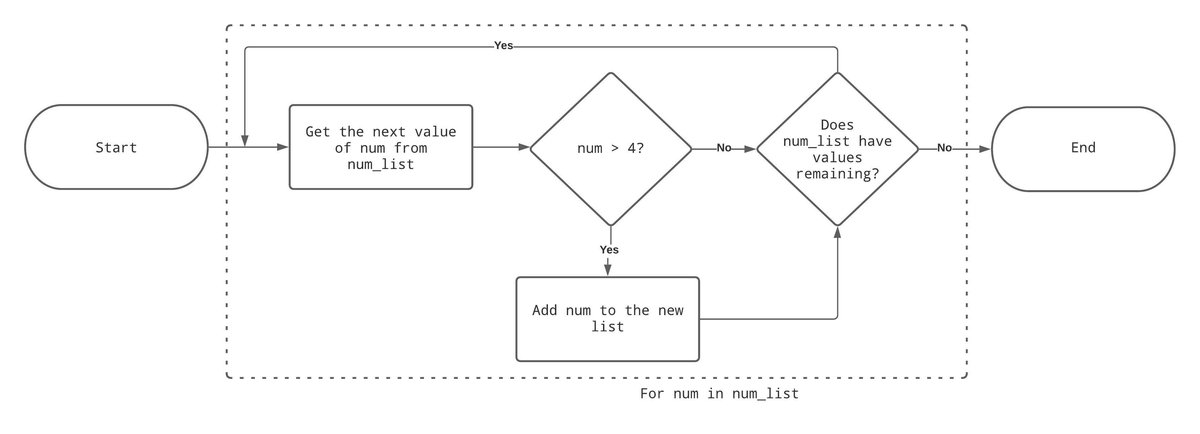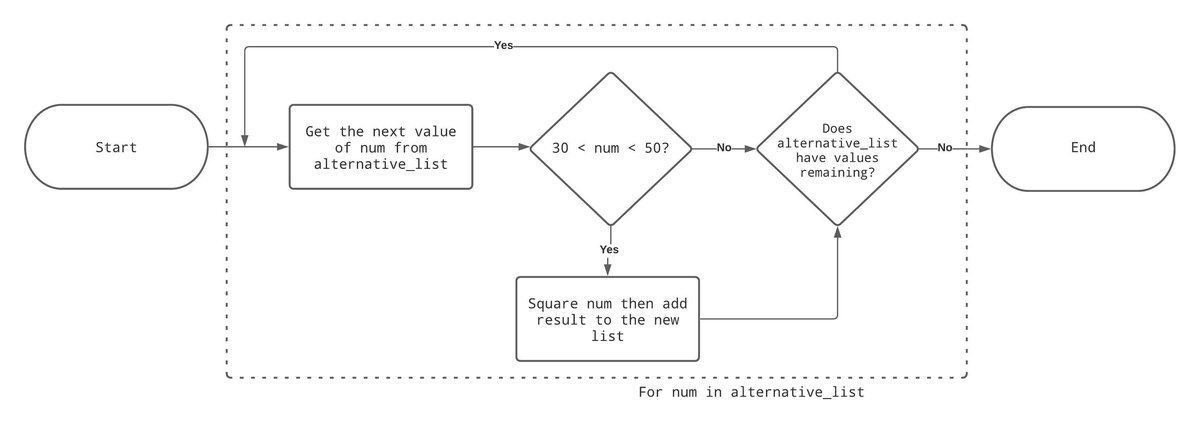Python List Comprehension: single, multiple, nested, & more
LearnDataSci is reader-supported. When you purchase through links on our site, earned commissions help support our team of writers, researchers, and designers at no extra cost to you.
The general syntax for list comprehension in Python is:
Quick Example
We've got a list of numbers called num_list, as follows:
Using list comprehension, we'd like to append any values greater than ten to a new list. We can do this as follows:
This solution essentially follows the same process as using a for loop to do the job, but using list comprehension can often be a neater and more efficient technique. The example below shows how we could create our new list using a for loop.
Using list comprehension instead of a for loop, we've managed to pack four lines of code into one clean statement.
In this article, we'll first look at the different ways to use list comprehensions to generate new lists. Then we'll see what the benefits of using list comprehensions are. Finally, we'll see how we can tackle multiple list comprehensions.
How list comprehension works
A list comprehension works by translating values from one list into another by placing a for statement inside a pair of brackets, formally called a generator expression.
A generator is an iterable object, which yields a range of values. Let's consider the following example, where for num in num_list is our generator and num is the yield.
In this case, Python has iterated through each item in num_list, temporarily storing the values inside of the num variable. We haven't added any conditions to the list comprehension, so all values are stored in the new list.
Conditional statements in list comprehensions
Let's try adding in an if statement so that the comprehension only adds numbers greater than four:
The image below represents the process followed in the above list comprehension:
We could even add in another condition to omit numbers smaller than eight. Here, we can use and inside of a list comprehension:
But we could also write this without and as:
When using conditionals, Python checks whether our if statement returns True or False for each yield. When the if statement returns True, the yield is appended to the new list.
Adding functionality to list comprehensions
List comprehensions aren't just limited to filtering out unwanted list values, but we can also use them to apply functionality to the appended values. For example, let's say we'd like to create a list that contains squared values from the original list:
We can also combine any added functionality with comparison operators. We've got a lot of use out of num_list, so let's switch it up and start using a different list for our examples:
In the above example, our list comprehension has squared any values in alternative_list that fall between thirty and fifty. To help demonstrate what's happening above, see the diagram below:
Using comparison operators
List comprehension also works with or, in and not.
Like in the example above using and, we can also use or:
Using in, we can check other lists as well:
Likewise, not in is also possible:
Lastly, we can use if statements before generator expressions within a list comprehension. By doing this, we can tell Python how to treat different values:
The example above stores values in our new list if they are greater than forty; this is covered by num if num > 40. Python stores zero in their place for values that aren't greater than forty, as instructed by else 0. See the image below for a visual representation of what's happening:
Multiple List Comprehension
Naturally, you may want to use a list comprehension with two lists at the same time. The following examples demonstrate different use cases for multiple list comprehension.
Flattening lists
The following synax is the most common version of multiple list comprehension, which we'll use to flatten a list of lists:
The order of the loops in this style of list comprehension is somewhat counter-intuitive and difficult to remember, so be prepared to look it up again in the future! Regardless, the syntax for flattening lists is helpful for other problems that would require checking two lists for values.
Nested lists
We can use multiple list comprehension when nested lists are involved. Let's say we've got a list of lists populated with string-type values. If we'd like to convert these values from string-type to integer-type, we could do this using multiple list comprehensions as follows:
Readability
The problem with using multiple list comprehensions is that they can be hard to read, making life more difficult for other developers and yourself in the future. To demonstrate this, here's how the first solution looks when combining a list comprehension with a for loop:
Our hybrid solution isn't as sleek to look at, but it's also easier to pick apart and figure out what's happening behind the scenes. There's no limit on how deep multiple list comprehensions can go. If list_of_lists had more lists nested within its nested lists, we could do our integer conversion as follows:
As the example shows, our multiple list comprehensions have now become very difficult to read. It's generally agreed that multiple list comprehensions shouldn't go any deeper than two levels; otherwise, it could heavily sacrifice readability. To prove the point, here's how we could use for loops instead to solve the problem above:
Speed Test: List Comprehension vs. for loop
When working with lists in Python, you'll likely often find yourself in situations where you'll need to translate values from one list to another based on specific criteria.
Generally, if you're working with small datasets, then using for loops instead of list comprehensions isn't the end of the world. However, as the sizes of your datasets start to increase, you'll notice that working through lists one item at a time can take a long time.
Let's generate a list of ten thousand random numbers, ranging in value from one to a million, and store this as num_list. We can then use a for loop and a list comprehension to generate a new list containing the num_list values greater than half a million. Finally, using %timeit, we can compare the speed of the two approaches:
| type | microseconds | |
|---|---|---|
| 1 | list comprehension | 288.85 |
| 0 | for loop | 416.94 |
The list comprehension solution runs twice as fast, so not only does it use less code, but it's also much quicker. With that in mind, it's also worth noting that for loops can be much more readable in certain situations, such as when using multiple list comprehensions.
Ultimately, if you're in a position where multiple list comprehensions are required, it's up to you if you'd prefer to prioritize performance over readability.
Summary
List comprehensions are an excellent tool for generating new lists based on your requirements. They're much faster than using a for loop and have the added benefit of making your code look neat and professional.
For situations where you're working with nested lists, multiple list comprehensions are also available to you. The concept of using comprehensions may seem a little complex at first, but once you've wrapped your head around them, you'll never look back!





